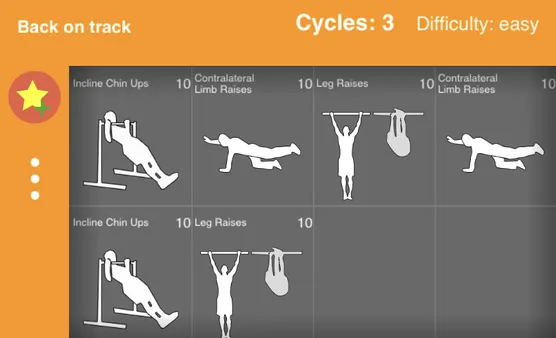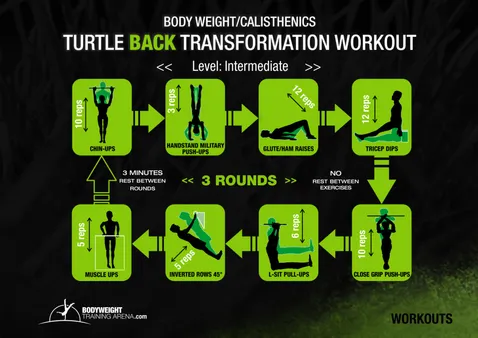Table of Contents
Calisthenics, the art of bodyweight training, offers a plethora of exercises to sculpt a strong and defined back. Engaging in a calisthenics back workout routine not only enhances aesthetics but also improves overall fitness and mobility. At Kizworld, we delve into the world of calisthenics back workouts, providing a comprehensive guide to exercises, benefits, and safety considerations. Whether you're a seasoned athlete or just starting your fitness journey, this guide will empower you to achieve your back-building goals.
The Ultimate Calisthenics Back Workout: Build a Strong and Defined Back
Level | Exercise | Difficulty |
|---|---|---|
Beginner | Pull-Ups | Easy |
Beginner | Inverted Rows | Easy |
Beginner | Supermans | Easy |
Beginner | Back Extensions | Easy |
Intermediate | Muscle-Ups | Hard |
Intermediate | Weighted Pull-Ups | Hard |
Intermediate | Tuck Front Lever Rows | Hard |
Intermediate | Wide-Grip Pull-Ups | Hard |
Advanced | One-Arm Pull-Ups | Very Hard |
Advanced | Weighted Muscle-Ups | Very Hard |
Advanced | Planche | Very Hard |
Advanced | Dragon Flag | Very Hard |
I. Calisthenics Back Workout Variations: Plyometric vs. Isometric Exercises
Plyometric Exercises
Plyometric exercises are explosive movements that involve a rapid stretching and contracting of the muscles. These exercises are great for building power and speed. Some examples of plyometric back exercises include:
- Muscle-ups
- Weighted pull-ups
- Tuck front lever rows
- Wide-grip pull-ups
Isometric Exercises
Isometric exercises are exercises that involve holding a position for a period of time. These exercises are great for building strength and endurance. Some examples of isometric back exercises include:
- Planche
- Dragon flag
- Back extensions
- Supermans
Which Type of Exercise is Right for You?
The type of calisthenics back workout that is right for you will depend on your fitness goals. If you are looking to build power and speed, then plyometric exercises are a good option. If you are looking to build strength and endurance, then isometric exercises are a good option.
Exercise Type | Benefits |
|---|---|
Plyometric | Builds power and speed |
Isometric | Builds strength and endurance |
No matter what type of calisthenics back workout you choose, make sure to start slowly and gradually increase the intensity of your workouts over time. This will help you to avoid injury and get the most out of your workouts.
Calisthenics Back Workout Variations: Plyometric vs. Isometric Exercises
II. Effective Calisthenics Back Exercises: Beginner to Advanced
Beginner Exercises
Calisthenics back workouts are a great way to build strength and muscle without any equipment. They are also a great way to improve your posture and flexibility. If you are new to calisthenics, start with these beginner exercises:
Exercise | Difficulty |
|---|---|
Pull-Ups | Easy |
Dips | Easy |
Push-Ups | Easy |
Squats | Easy |
Planks | Easy |
Intermediate Exercises
Once you have mastered the beginner exercises, you can move on to these intermediate exercises:
Exercise | Difficulty |
|---|---|
Muscle-Ups | Hard |
Handstands | Hard |
Back Levers | Hard |
Front Levers | Hard |
Planches | Hard |
Advanced Exercises
If you are looking for a challenge, try these advanced exercises:
Exercise | Difficulty |
|---|---|
One-Arm Pull-Ups | Very Hard |
Weighted Pull-Ups | Very Hard |
Weighted Dips | Very Hard |
Human Flags | Very Hard |
Dragon Flags | Very Hard |
Effective Calisthenics Back Exercises: Beginner to Advanced
III. Calisthenics Back Workout Plan: A Step-by-Step Guide
To get started with your calisthenics back workout, you'll need to choose a few exercises that target different muscle groups. Some good beginner exercises include pull-ups, inverted rows, supermans, and back extensions. Once you've mastered these exercises, you can start to add more challenging variations, such as muscle-ups, weighted pull-ups, tuck front lever rows, and wide-grip pull-ups. For more advanced athletes, one-arm pull-ups, weighted muscle-ups, planche, and dragon flag are excellent exercises to incorporate into your routine.
When creating your calisthenics back workout plan, it's important to consider your fitness level and goals. If you're a beginner, start with a few simple exercises and gradually add more challenging variations as you get stronger. It's also important to listen to your body and rest when you need to. With consistency and dedication, you'll be able to build a strong and muscular back using calisthenics.
Level | Exercise | Difficulty |
|---|---|---|
Beginner | Pull-Ups | Easy |
Beginner | Inverted Rows | Easy |
Beginner | Supermans | Easy |
Beginner | Back Extensions | Easy |
Intermediate | Muscle-Ups | Hard |
Intermediate | Weighted Pull-Ups | Hard |
Intermediate | Tuck Front Lever Rows | Hard |
Intermediate | Wide-Grip Pull-Ups | Hard |
Advanced | One-Arm Pull-Ups | Very Hard |
Advanced | Weighted Muscle-Ups | Very Hard |
Advanced | Planche | Very Hard |
Advanced | Dragon Flag | Very Hard |
Here is a sample calisthenics back workout plan that you can follow:
- Pull-Ups: 3 sets of 8-12 repetitions
- Inverted Rows: 3 sets of 10-15 repetitions
- Supermans: 3 sets of 15-20 repetitions
- Back Extensions: 3 sets of 15-20 repetitions
Rest for 1-2 minutes between sets and 2-3 minutes between exercises. As you get stronger, you can increase the number of sets, repetitions, or weight. You can also add more challenging exercises to your routine.
If you're new to calisthenics, it's important to start slowly and gradually increase the intensity of your workouts. Listen to your body and rest when you need to. With consistency and dedication, you'll be able to build a strong and muscular back using calisthenics.
Here are some additional tips for getting the most out of your calisthenics back workout:
- Focus on proper form to avoid injury.
- Challenge yourself with progressive overload.
- Be patient and consistent with your training.
- Listen to your body and rest when you need to.
- Have fun and enjoy the process!
With these tips in mind, you're well on your way to building a strong and muscular back using calisthenics.
Related Posts:
- How to Do a Muscle-Up
- The Best Calisthenics Gifts and Accessories
- The Best Calisthenics Quotes and Motivation
Calisthenics Back Workout Plan: A Step-by-Step Guide
IV. Calisthenics Equipment for a Comprehensive Back Workout
Working out at home or in a public park is quite accessible and does not take up much of your space or time. Calisthenics workout is suited for beginners and a step-by-step calisthenics back workout plan is available in our How to train like a calisthenics pro article. Calisthenics only requires your body and possibly a pull-up bar to get started. Almost anyone can get started right away and you can slowly progress and get more advanced over time. Calisthenics exercises are an excellent way to strengthen and define your back muscles. With a few pieces of basic equipment, you can perform a variety of back exercises that will target all the major muscle groups in your back.
Here is a list of basic equipment you will need for a comprehensive back workout:
- Pull-up bar: A pull-up bar is essential for performing exercises like pull-ups, chin-ups, and muscle-ups. You can purchase a stand-alone pull-up bar or a portable one that can be attached to a doorway or tree branch. Our how to do a muscle-up article will let you know all about muscle-ups.
- Resistance bands: Resistance bands are a versatile piece of equipment that can be used for a variety of back exercises, including rows, flyes, and pull-aparts. They are a great option for home workouts because they are portable and affordable.
- Gymnastic rings: Gymnastic rings are another great option for back workouts. They can be used for a variety of exercises, including pull-ups, dips, and rows. Rings are more challenging than a pull-up bar, but they also allow for a greater range of motion.
- Weight vest: A weight vest can be added to your back workout to increase the difficulty of your exercises. Weight vests are available in a variety of weights, so you can choose one that is appropriate for your fitness level. Our different calisthenics exercises and variations will how other variations you can incorporate into your workout.
- Dip station: A dip station is a great piece of equipment for building triceps and chest muscles, but it can also be used for back exercises like dips and rows. Some dip stations also have a pull-up bar attached to it.
With these basic pieces of equipment, you can perform a variety of back exercises that will help you build strength, improve your posture, and get in shape. You can find more about calisthenics back workout variations: plyometric vs. isometric exercises in our Calisthenics Back Workout Variations: Plyometric vs. Isometric Exercises article.
Calisthenics Equipment for a Comprehensive Back Workout